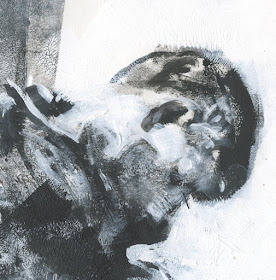The NYT explained its goal for the cover: "Like all great athletes, Roger Federer makes the impossible look easy. So we decided to go with an action shot that captures his grace and dynamism."
My dictionary doesn't recognize these uses of the terms, "action" and "dynamism." To me the freeze frame photo of Federer hovering in air looks inert and static. There is no suggestion of speed, and in fact the strangely meandering word "wonder" (in random type faces in miscellaneous sizes) dominates the figure and neutralizes any semblance of movement or direction or thrust. The visual emphasis placed on an outstretched hand releasing a ball seems to be the antithesis of "dynamism."
A few years ago on this blog I wrote about how sports illustration in the 1950s tended to rely on frozen, stop-motion images that looked hopelessly stolid.
Then in the 1960s, imaginative illustrators developed fresh ways to capture speed. They learned from action painting and abstract expressionism in the fine art world; they learned from movies, by blurring or repeating images rather than carefully capturing a single Muybridge snapshot; they learned from impressionism and expressionism (going back to J.M.W. Turner's revolutionary masterpiece, Rain, Steam and Speed); they learned from Einstein's special theory of relativity that spacetime bends as velocity increases toward the speed of light.
The following examples are from Bernie Fuchs' brilliant illustrations for Sports Illustrated in 1961.
 |
| Note the figure in the foreground starting to stretch to the right with Einstein's spacetime. |
He used slashing lines and rapid brush strokes to create sensations of speed.
 |
| Detail |
He captured figures in truly dynamic poses with traction and thrust, not merely floating in air. He selectively used sharp focus or blur to convey motion and emphasis. These are among the tools of a sophisticated artist.
If the goal of yesterday's NYT Magazine cover was "action" and "dynamism," I think by comparison these 1960s examples make the cover look sick. How much we have forgotten!
The concept of "progress" applies in science but not so much in art. In science, each new generation can build on the objective discoveries of the generation before. But in art, prehistoric cave paintings may be just as beautiful and sensitive as a picture made yesterday. It's not unusual for art to take one step forward and two steps back. But if we are aware of our history and work in good conscience, it's at least possible to take two steps forward and only one step back.





























